Last Updated on November 4, 2024
This post was sponsored by Adobe Express. All thoughts and opinions are my own; for more information, please see my disclosure policy.
Since moving to Maine, I get the fall hype. I finally get it. I have never seen trees that are so colorful. The air is crisp. Cliché, but true. And I’m not even sure how to describe crisp air. But I think it’s like true love. You can’t really explain it, but you know it when you feel it.
The colder weather and crisp air make me excited to put on warm and cozy clothes. I want to wrap up in a big scarf and embrace this season’s magic in every way possible.
And the magic of this season…. isn’t something you can buy, even though a quick scroll through my Instagram feed might have you believe otherwise.
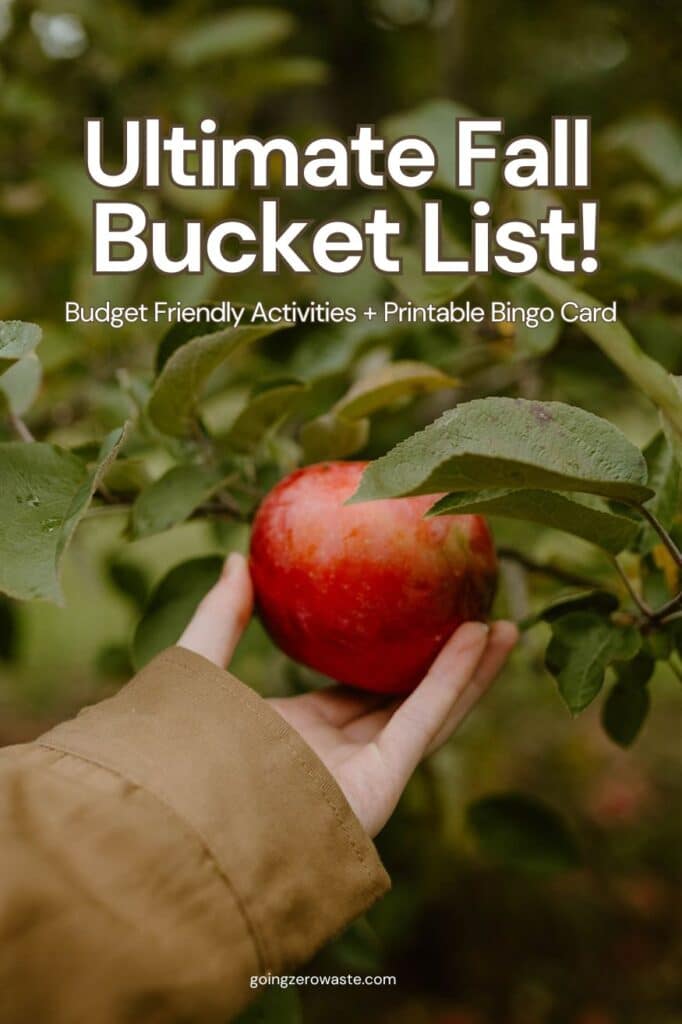
There can be a lot of waste this time of year, from giant hauls of clothing, seasonal decor, beauty and body products that won’t be used entirely by the time we need to swap for the next holiday scent, single-use poorly constructed costumes, single-use plastic cups for fall drinks, and the list goes on.
We often use buying things as a replacement for connection. Instead, focus on the connection. While I don’t think it’s inherently wrong to want to enjoy fall fashion, decorate for the season, and fall-inspired treats, I do think that the magic of the season goes so much deeper than what you can buy.
Fall is about slowing down as we head into winter. It’s about darker nights, connecting with our loved ones, and enjoying the bounty of harvest and some of our favorite fall foods. And we can do all of that in a sustainable way that makes us feel truly connected to the season and the people we care about.
In truth, you don’t need a bunch of new stuff to enjoy fall. And you certainly don’t have to sacrifice your favorite fall activities to be sustainable. So here are some ways to keep your fall eco-friendly and enjoy the essence of the season.
fall bingo
To fully embrace this season, I made a fall bingo card using Adobe Express. This is a fun game and a reminder to celebrate the season sustainably and fully. You can even share or compete with your friends and family. (annnd maybe encourage them to participate in some sustainable fall habits too??)
I wanted to make a bingo card to go beyond just a checklist because the visual nature and gamification encourages me to really make these fall activities a priority.
Plus, it’s just FUN. I was so excited when I got my bingo this year!!

If you’d rather download a pdf, I can email that to you with the form below. It will automatically sign you up for my weekly newsletter where I share more sustainability tips, but you can unsubscribe at anytime.
If I don’t make a plan to go out and enjoy the season, I can often get too wrapped up in day-to-day, that I miss out on so many fun moments. Allowing myself to print and hang the bingo sheet on my fridge, I’m reminded of all the fun ways I can celebrate the season.
I made this bingo sheet with Adobe Express. They made it so easy because I can easily choose from various templates, making it simple even for non-designers.
The templates are fully customizable, so I could adapt each section to fit the activities and eco-friendly values I wanted to showcase. The platform’s user-friendly tools allowed me to adjust colors, add icons, and play around with fonts to give the sheet a festive fall-themed look.
I love the intuitive features, making it easy to design something unique in minutes without any complicated steps. If you’re interested in creating your own seasonal games or personalized checklists, Adobe Express is a fantastic option for putting together visually appealing projects with ease.
Here’s a look at a few of my favorite bingo sheet squares!
1. pumpkin and apple picking
This is a fall classic, and I got to check both of these boxes off of my bingo sheet this year!
If you love stocking up on apples and pumpkins, consider hitting up a local pumpkin patch and apple orchard. It’s so important to support small, local farms. Not only is it fun, it’s a great way to connect more with your local food systems.
Small farms support the local economy by providing jobs, strengthening the community, and helping maintain rural populations.
Small farms can help protect and enhance the environment by preserving land and creating a good landscape. They can also increase biodiversity by growing heirloom and non-commercial varieties of plants.

Check and see if you can find any local farms near you that use organic and/or regenerative farming practices too!
But don’t forget to use up all the apples and pumpkins you get! Especially pumpkins: 1.3 billion pounds of pumpkins go uneaten and get sent to landfills in the U.S. alone each year.
Here are some creative ways to use up your apples and pumpkins.
Apples:
And you can save your scraps and cores to make homemade Apple Cider Vinegar from Scraps!
Pumpkins:
For more ideas check out my latest book 101 Tips For a Zero Waste Kitchen, with tons of food waste-fighting recipes!
2. fall drinks
There are so many delicious fall drinks that come out this time of year. From apple cider to pumpkin spice lattes, there’s no shortage of options.
I have three squares on the bingo card dedicated to fun fall drinks because you don’t have to give them up to be sustainable. Just consider bringing your own reusable travel mug with you and asking for it to go in there.
So far I’ve gotten hot apple cider and a pumpkin spice coffee blend. So, I have one more fall drink to try before December!
Also, if you have some extra time, most small cafes are more likely to provide you with actual mugs if you get your drink to stay. And what’s not more aesthetically pleasing than sipping on a fall drink in a cute cafe?
You can also make your own fall drinks at home. One of my favorites is mulled apple cider (even better if you get it from the local farmers market). Here’s how to make it.
mulled apple cider recipe
Ingredients:
- Apple cider
- Orange slices
- Cinnamon sticks
- Whole cloves
Instructions:
- In a pot, add as much apple cider as you’d like (this will depend on how many people you’re serving – a gallon should be enough for 7-8 people). Add in your orange slices, cinnamon sticks, and whole cloves.
- Bring it to a boil, then reduce to a simmer for ~30 minutes.
- When it’s done, strain out the extras and serve in reusable mugs!
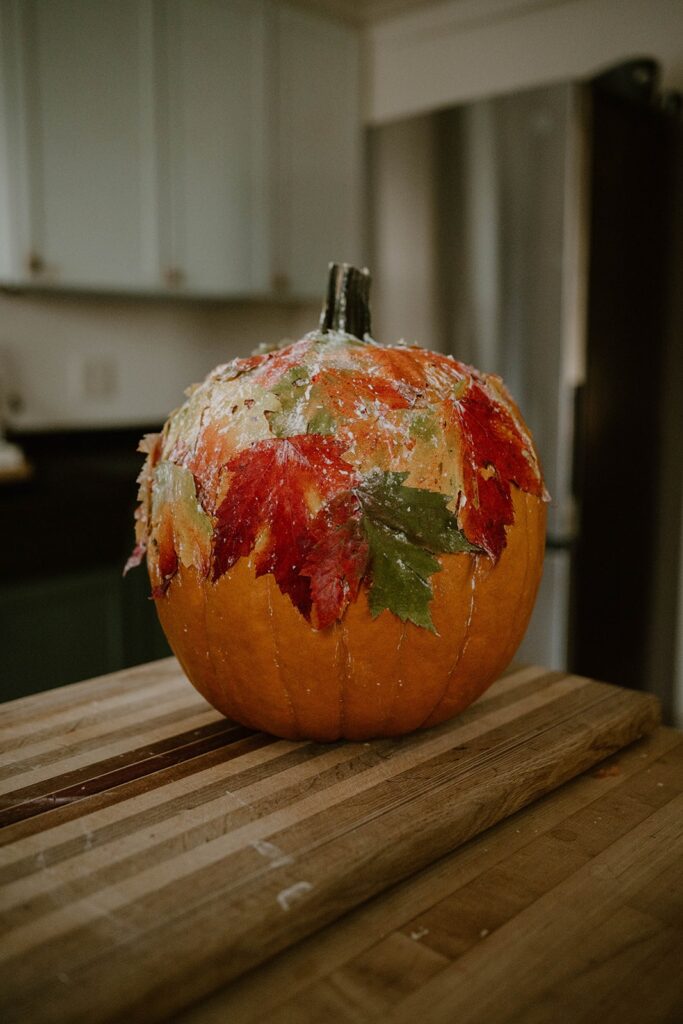
3. diy fall crafts
You really don’t need to go out and buy a bunch of new fall decor. Nature has provided us with so many beautiful options, so lean in. I love to decorate with gourds and pumpkins that can be eaten. You can make a beautiful garland with leaves that can be composted.
Of course, the most sustainable option is to use what you have. Shop secondhand and consider DIYing some fall crafts and decor instead.
I love to draw inspiration from the items I see on Instagram or in stores and then make my own version using secondhand or upcycled materials like scrap fabric, salvaged paper from gifts or packages, and cardboard from boxes. But using natural materials for your crafts is great too, as these can be composted, like foraged fall leaves, acorns and twigs.
Here are some fall DIYs I love:
4. cook using in-season fall produce
Visiting your local farmers market is a great way to see what’s in season near you. This will vary from state to state due to the climate in your region. For example, California is warmer than New York, so it makes sense that more produce is available during the winter months.
However, be mindful that what’s sold at your local market will also depend on what your local farmers choose to grow that year. Many things can factor into this decision, like the cost of growing versus the profit of selling.
Here’s a general list of what’s typically in season for fall:
- Apples
- Pears
- Plums
- Figs
- Pumpkins
- Winter squash (butternut, acorn squash, kabocha etc.)
- Broccoli
- Cauliflower
- Brussels sprouts
- Sweet potatoes
- Cabbage
- Carrots
- Celery
- Chard
- Parsnips
- Garlic
- Onions
- Herbs
- Kale
- Leeks
- Potatoes
- Spinach
- Turnips
- Peppers
I cannot wait to make my dad’s award winning chili, miso white bean stew, and all of roasted squash dishes! I’m a member of a vegan dinner party group, and we do a big Friendsgiving potluck every year and a soup party. The party is hosted by a vegan, but no one else in the group is vegan so this a great way to encourage more plant based eating and creativity.
Please note the Potluck square on the bingo sheet, and let me tell you a soup party truly is life changing. Every time we host one of these, we all bring the recipes to share with each other.
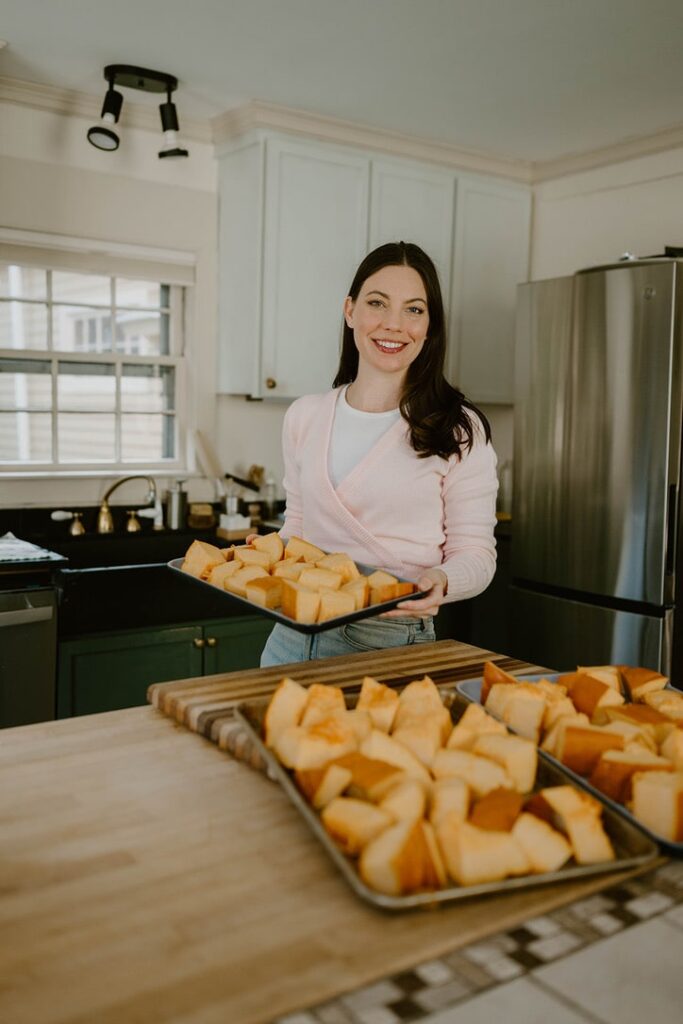
My favorite dish so far was brought by one of my friends! It’s a kabocha squash stuffing with maple tempeh that has become one of the recipes I look forward to all year long.
When you choose to support locally grown produce, you’re reducing food miles (aka, how long it takes for your food to get to you). Market produce is often grown in the same or neighboring states instead of across the country or overseas.
You can also sign up for a local CSA box if you have access to one. They will curate a weekly or bi-weekly box of seasonal produce from a local farm. Many offer delivery straight to your door, or have a designated pick-up spot.
Cooking at home also helps reduce waste and connects you to your food more. When you buy your produce fresh, there’s less packaging waste. Plus, fresh food goes bad faster, which allows you to think up yummy ways to utilize it in your cooking.
My tip? Keep fresh foods within sight so you’re more likely to reach for them. And meal plan whenever possible!
5. make your own costume
So many of the costumes you find online and in stores are made from cheap materials, like polyester. They’re only built to last one night and easily fall apart.
That essentially means thousands of Halloween costumes will be heading to the landfill after the holiday is over. (source) And remember: Polyester is just another term for plastic fabric. So it won’t break down and likely, cannot be recycled.
Plus, costumes can cost a lot of money, depending on what you’re going as. A costume can easily cost $50-80.
Instead, why not make your own? Here are some ways you can. I guarantee you, you’ll look so much better, reduce waste and save a lot of money.
shop your closet first
You probably already have clothes in your wardrobe that would make a great costume! I recently challenged myself to make seven costumes from one black dress, and it was a blast.
You can also get a few accessories that can easily change almost any basic look and allow you to lean into what you already have.
- animal ears paired with any clothing will make an easy costume
- a crown paired with any fancy dress will be a princess
- wings will make any slightly flowy and whimsical dress a fairy
- a witch hat will make any black dress look like a witch costume
- a cowboy hat and jeans will instantly make you from the wild west
thrifting, renting, swapping
You can thrift or rent your Halloween costume, too! There are SO many Halloween costumes available at your local thrift store, many of which haven’t even been worn.
There are also some amazing costume rental companies – just google ones near you and see what pops up.
You can also try renting normal clothing that looks ‘costume-like’ and fits into whatever character you’re aiming for. This is a great option if you know the item you want for the costume will never be worn again.
For example, maybe you want to go as a leopard, but don’t enjoy wearing leopard print on a consistent basis. Renting is a great option to reduce waste: You get to use it with the comfort of knowing someone else will keep it in use after you.
And don’t forget going to a costume swap or just swapping with friends and family. It’s a great way to get a new-to-you costume for free.
diy costumes
If you’re especially crafty, you can probably put your entire costume together yourself using some basic sewing skills. Head to a fabric store (or even better yet, fashion one from fabric scraps/secondhand fabrics) and grab whatever you’ll need.
You don’t have to sew your costume to DIY it either: You can get crafty by upcycling all kinds of materials to create a costume, like cardboard, aluminum, and jewelry.
I recently crafted an impromptu bug costume and made my own antennas out of a headband, a clothing hanger and some ribbon!
6. go leaf peeping
A simple way to reconnect with nature is to go leaf peeping. All you need to do is pick a location, research the area, and bring the right gear.
This bingo sheet is really about slowing down and connecting with the season in a less consumer driven way. Taking a nature walk, leaf peeping, stargazing, even crafting are all ways to help you slow down from the day-to-day.
I recommend visiting a local state forest and going on a fall hike to get the best view of the colorful leaves.
Maine is known for its forests, so if you’re in the area, I highly recommend checking them out! Upstate New York, Massachusetts, Oregon, and Vermont also have some impeccable fall foliage worth checking out.
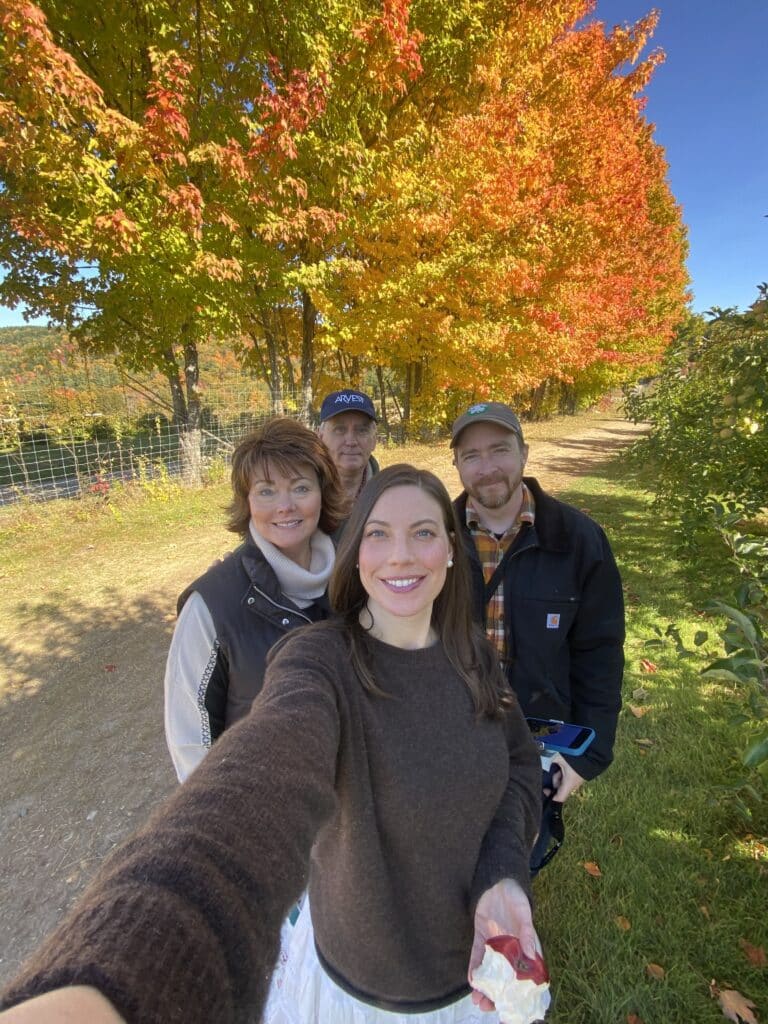
You can sustainably prep for your trip by:
- Packing some zero waste snacks! I love grabbing some granola, chocolate covered raisins, and pistachios at the bulk food store. Bringing some fresh fruit, like apples and pears is great too. You can also make some homemade protein bars and store them in a reusable silicone bag.
- Bring some sustainable hiking gear! For fall, flannel, comfy pants, and hiking boots are a must! Don’t forget a sturdy hiking backpack, a compass, a flashlight, and some binoculars. Don’t forget your reusable water bottle either!
- Choose eco-friendly routes on Google Maps if possible to get there. Just make sure to turn on ‘prefer fuel-efficient routes’ under route options.
Of course, if you’re unable to make it to a forest for a hike, you can always simply walk through your local park to see the leaves. Enjoying the foliage in your own backyard is easy and hassle free!
7. attend a pumpkin smashing event
Did you know 1.3 billion pounds of pumpkins are trashed annually after Halloween and Thanksgiving? (source USDA) We should be eating our pumpkins – I listed some pumpkin recipes in the first section!
However, if you don’t like the taste of pumpkin, consider attending a local pumpkin smash event. You get to literally smash your pumpkin, and the remains get composted!
Another option is to see if your local farm, zoo, or animal sanctuary accepts pumpkin donations for the animals. They’ll enjoy eating them.
Also, if you have a dog, consider whipping up some homemade pumpkin dog treats. Nala loves it when I make her some!
8. host a fall themed event
Love hosting? Why not try hosting a fun fall themed event? It’s a great way to build connections, make memories, and get your loved ones into the spirit of seasonal, slow living.
Here are some fall-inspired friend nights, minus the waste:
- Seasonal inspired potluck: Ask your friends to cook a dish that uses at least one in-season produce item. Even better if they get it from your local market!
- Movie night: Invite your friends over to watch some cozy, wholesome films. Snacks can be popcorn you bought at the bulk bins and homemade treats!
- Candle making: Assemble the materials needed to make some natural beeswax, coconut or soy candles together. Just make sure to take the proper precautions and prepare to get messy!
- Pumpkin carving: Invite your friends over to carve pumpkins – but save the guts to make stock, and the seeds for roasting. Compost whatever you can’t reuse! You can even host a contest to see who makes the best one. Winner gets a fun eco-themed prize!
- Baking: Have your friends over for a bake night! Attempt to make something apple, pear, or pumpkin themed. Cinnamon rolls and raisin oatmeal cookies scream fall to me too!
- Bread-making: Attempt to make homemade bread together! Just note that bread tends to take a while to make and you may need to prep some of it in advance the day before.
- Painting fall-themed art: Using whatever art supplies you already have, challenge yourself to paint a fall scene. You can paint it on a traditional canvas, or get creative and use upcycled materials (like scrap paper, cardboard, seashells, wine bottles, etc.) as your canvas!
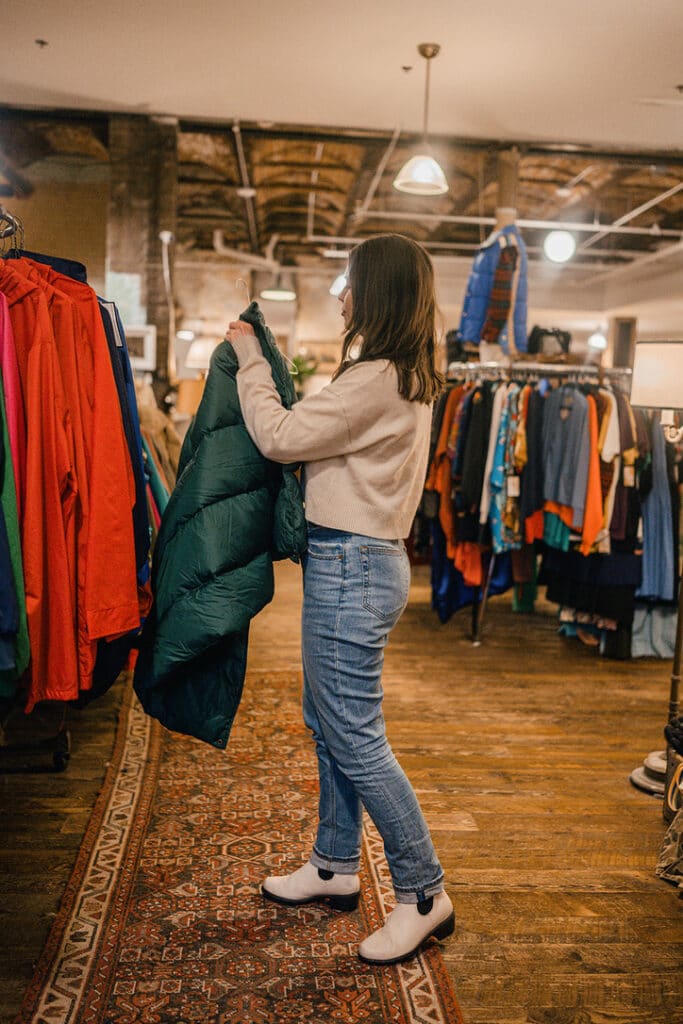
9. go thrifting for new fall clothes
This time of year, there’s a huge push to buy new boots and sweaters. We’re constantly bombarded with advertisements for the latest “fall fashion trends” and this leads to impulse purchases we probably don’t really need.
If you do need something new, or feel like you’re missing a fall staple in your wardrobe, consider thrifting for it first. Everything at the thrift store is secondhand, which means the materials needed to make it were already used up. Purchasing thrifted pieces means you’re keeping these items out of landfills and promoting reuse.
To make thrifting even more fun, consider going with a friend! Just make sure you ask yourself if you really need/will use the item you’re eyeing before purchase.
If you don’t have a thrift store near you, consider checking out one of these online thrift and vintage stores.
RELATED: 10 Sustainable Fall Must-Haves
10. tour a cidery
What’s more fall than apple cider? Consider checking to see if there are any local cideries near you. If there are, you can likely schedule a tour!
I actually got my first fun fall drink bingo check from freshly made apple cider to go in my own reusable cup!
You can ask them a bunch of questions about how they grow their apples, and if they use any sustainable practices. Also, many will let you sample their ciders in reusable glasses.
Cider itself is considered sustainable because it is fermented without heat, similar to wine, which means it uses less energy than other craft beverages. Cideries can also use clean energy to reduce their carbon footprint.
If you fall in love with the cider, you can purchase it straight from them. This helps support small farms, which is much better than purchasing it from the grocery store. You’re helping to empower your local economy, and supporting better farming practices.
–
So, which of these sustainable fall activities are you most excited to try out? Let me know in the comments!
And, a huge thank you to Adobe Express for sponsoring this post. Be sure to visit Adobe.com to create all kinds of images, videos, and documents, like the bingo card I made above!
I am definitely planning on making one for Christmas as well. I’ve always loved making seasonal bucket lists, but the bingo sheet makes it even more interactive and intentional.
The post Ultimate Fall Bucket List: Budget Friendly Activities + Printable Bingo Card appeared first on Going Zero Waste.
https://www.goingzerowaste.com/blog/ultimate-fall-bucket-list-budget-friendly-activities-printable-bingo-card/
Green Living
How Toad&Co’s Clothes Help Everyone Enjoy the Outdoors
This is a sponsored article about a brand that was independently assessed by our rigorous ratings system. We’re proud to only collaborate with “Good” and “Great” rated brands. Learn more.
US brand Toad&Co has a socially and environmentally responsible approach to clothing, creating pieces inspired by the outdoors and with a lower impact on the environment. Not to mention an enduring commitment to helping everyone get outdoors through its work with non-profits. Read on to discover the brand’s environment-first ethos.
Focusing on what matters most
“We make feel-good clothes for positive impact—fostering community around doing good, enjoying life’s simple pleasures, and embracing the unexpected,” says Sarah Palladino, director of people and impact at Toad&Co as she introduces the Californian brand. This “simple pleasures” concept applies to Toad&Co’s approach to design, too, and prioritises quality and responsibility over trend-led items. This, in turn, means the brand focuses its energy on clothes that are comfy and practical enough for everything from work to outdoor exploring, and on maintaining its ongoing commitments to using lower-impact materials, partnering with cleaner factories, and looking for new ways to do more with less.
Since day one, it’s been about more than just clothes. From choosing sustainable practices in every corner of our business to supporting programs that protect the planet and make the outdoors more accessible to everyone—knowing we stand for more is what keeps us going
Gordon Seabury – CEO at Toad&Co
Lower-impact materials and producer responsibility
Opting for lower impact materials is one of the core ways brands can address their impact on the planet: “Sustainable materials make a world of difference,” Toad&Co says. “We use organic cotton, recycled fibres, and other high-quality materials known for low-impact growing and cleaner manufacturing.”
The brand’s selection of more sustainable materials includes organic cotton, hemp, TENCEL Lyocell, and recycled fabrics like wool, cotton, and polyester. It also looks to third party clothing certifications like bluesign®, OEKO-TEX® STANDARD 100, and Global Organic Textile Standard, and it publishes its list of restricted substances for all to see.
Toad&Co also operates a resale platform, called ToadAgain, online and at its IRL store in Maine, US, to keep its clothes in the loop.
Supporting non-profits and access to the outdoors
Toad&Co donates 1% of its profits to organisations working to empower others and, in particular, enable better access to the outdoors for all.
In 1996, Toad&Co partnered with Search, Inc. to co-found the Planet Access Company, a full-functioning warehouse that trained and employed up to 70 adults with disabilities annually.
Determined not to stop at the front door, the brand also co-founded Search for Adventure in 2004, a unique travel program to facilitate vacations for adults with disabilities. Over 20 years later, the social venture partnership has evolved—and includes a flagship store in Chicago, a program called Visibility Arts that nurtures creativity through sharing Search, Inc. artist’s work, neurodiversity and disability awareness training, and an expanded Search for Adventure program. In 2024, the brand supported 147 nights of camping for adults with disabilities through the program.
We give back to—and partner with—organisations that align with our three pillars of giving: conservation for human enjoyment, equity and accessibility, and do the right thing
Sarah Palladino – director of people and impact at Toad&Co
One of Toad&Co’s key partnerships is with Brave Trails, which is dedicated to LGBTQ+ youth leadership, to support it in putting on accredited camps, mentorship programs, and meet-ups for LGBTQ+ youth.
Shop favourites from Toad&Co’s new collection
Read on to discover some of the standout items that balance style with practicality from Toad&Co’s lineup.
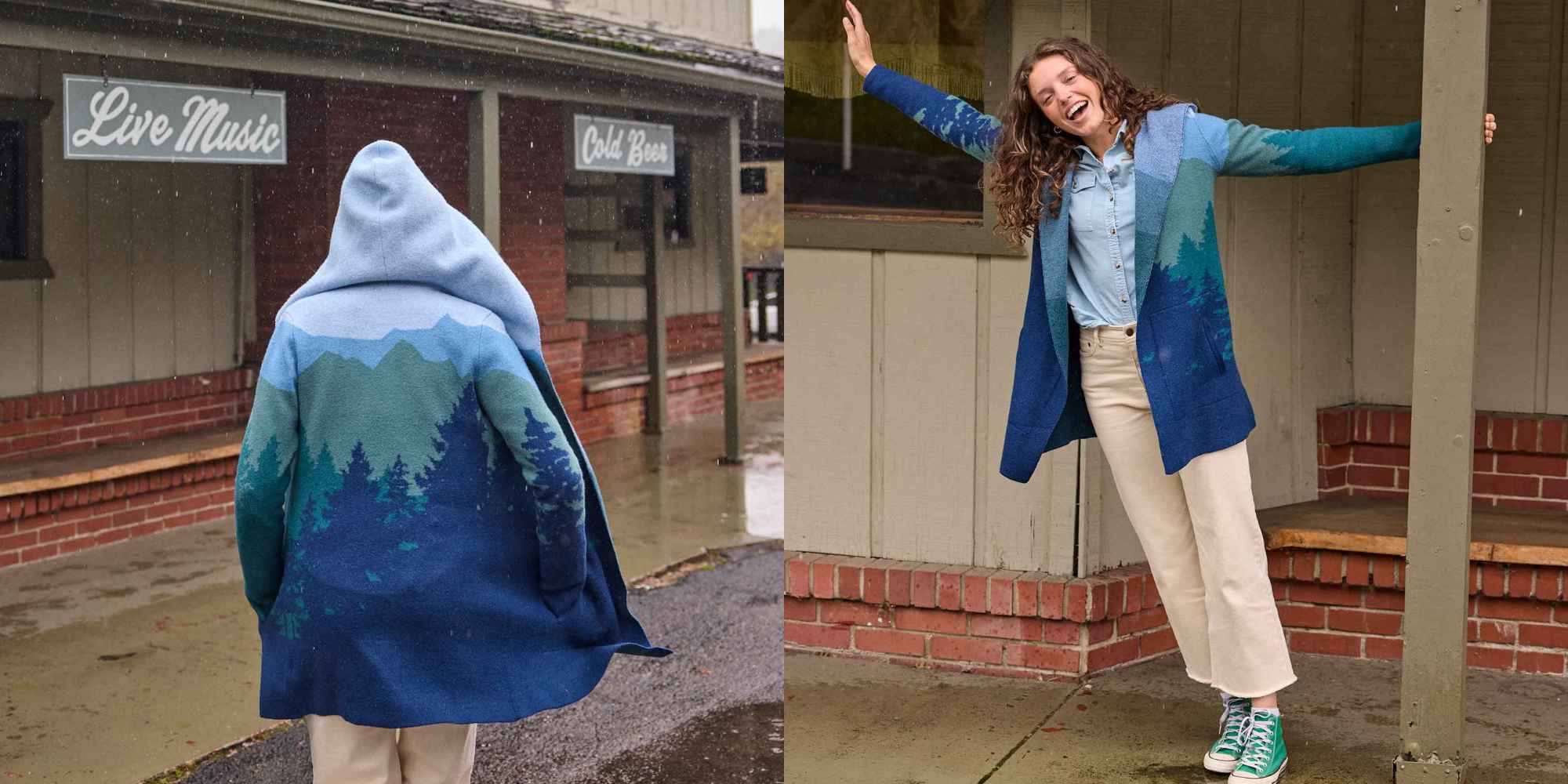
Woven with a beautiful alpine jacquard pattern, this hoodie is made from non-mulesed Merino wool and features pockets at the sides. It’s ideal as a mid-layer under a longer coat when you’re out exploring, or as a cosy item for grabbing a post-walk hot chocolate.
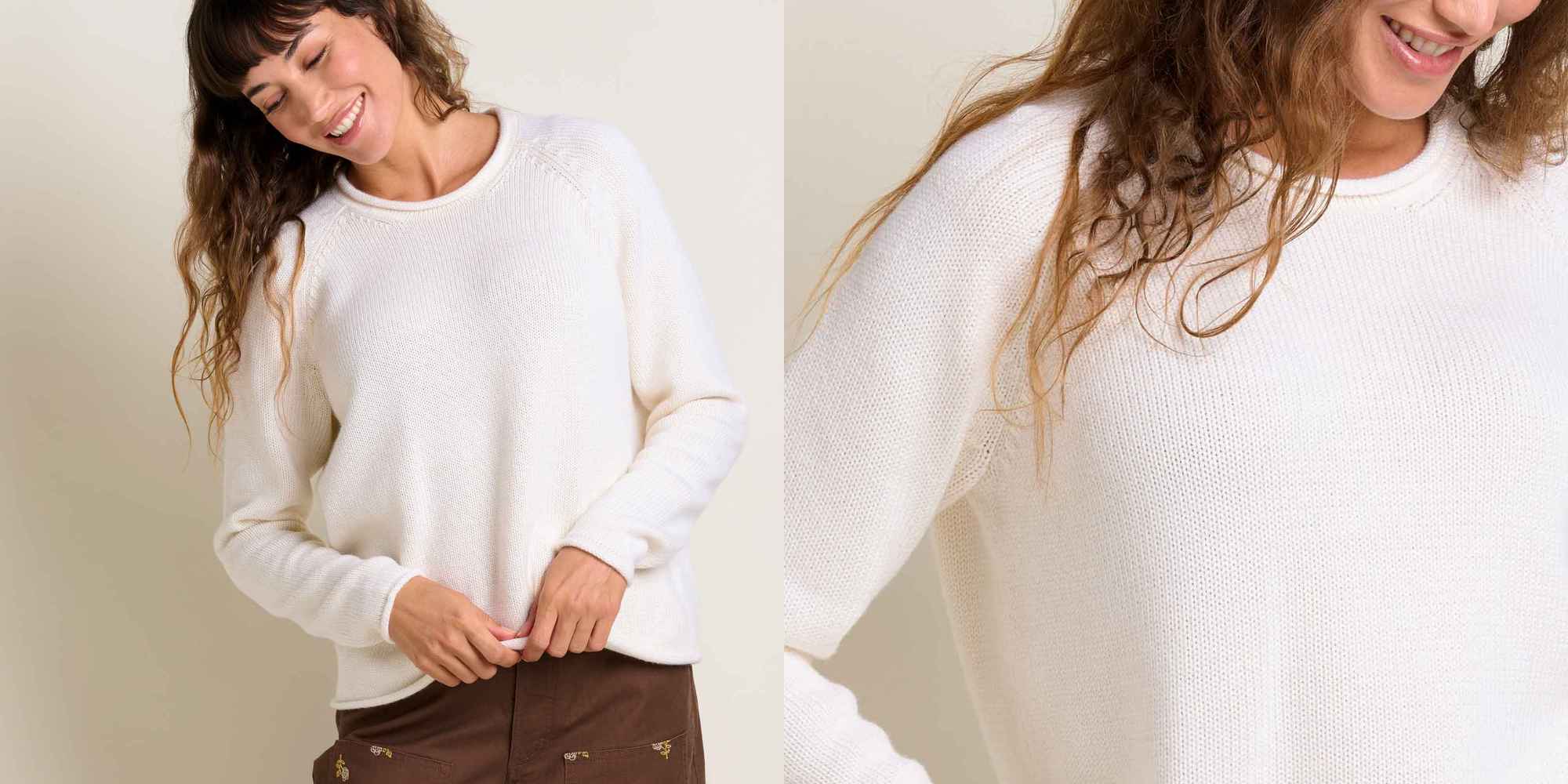
This Alpineglo sweater is a blend of 50% organic cotton and 50% non-mulesed Merino wool, so it’s going to help regulate your temperature in most climates. On top of that, the neutral tone and straight fit make it really versatile—you’ll be reaching for it on the regular.
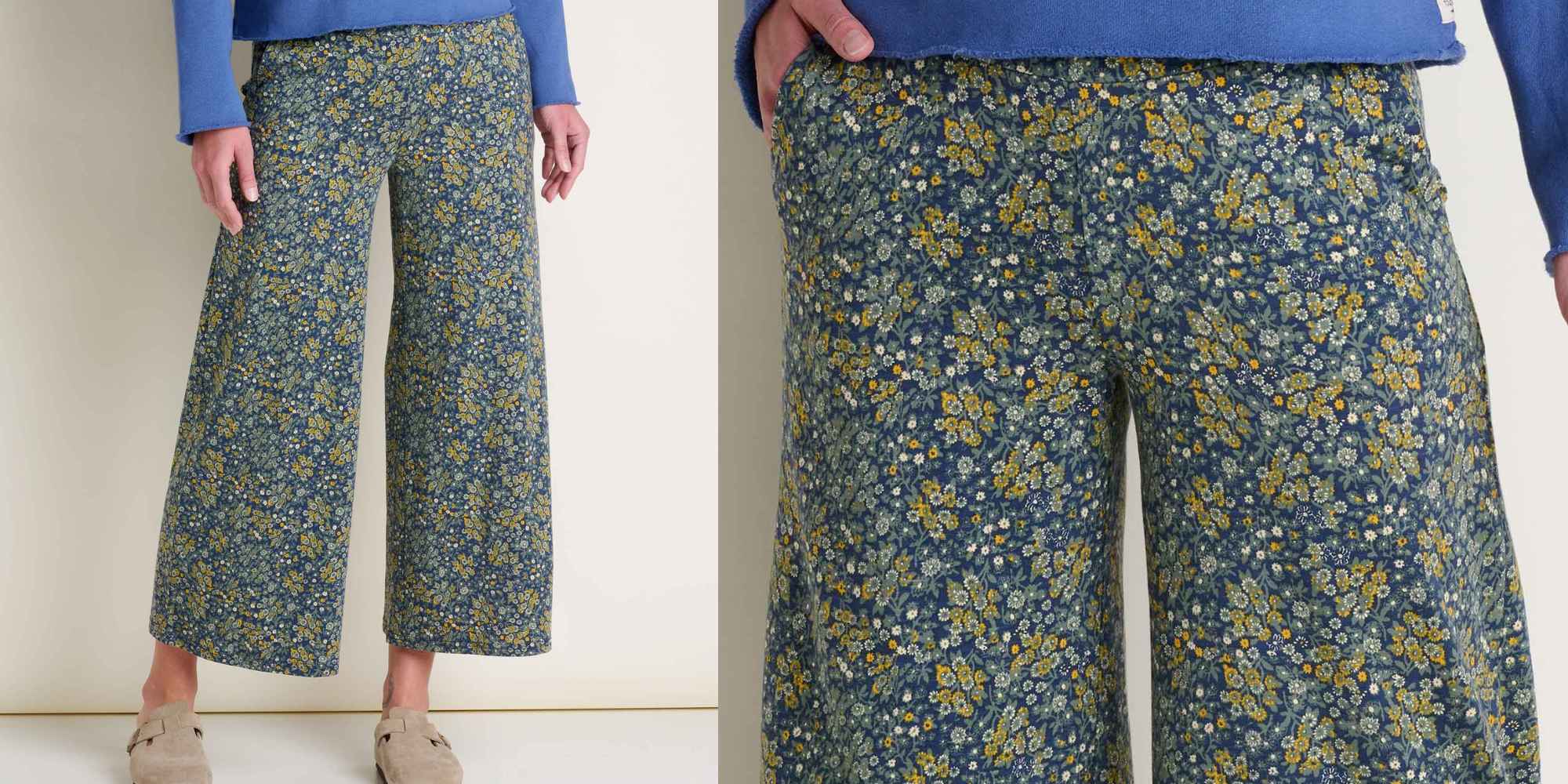
Toad&Co calls these cropped trousers “sweatpant comfortable, going-out presentable”, which makes sense, given they’re made with organic cotton and Tencel Lyocell for softness and have a comfortable wide waistband, not to mention a pretty floral pattern.
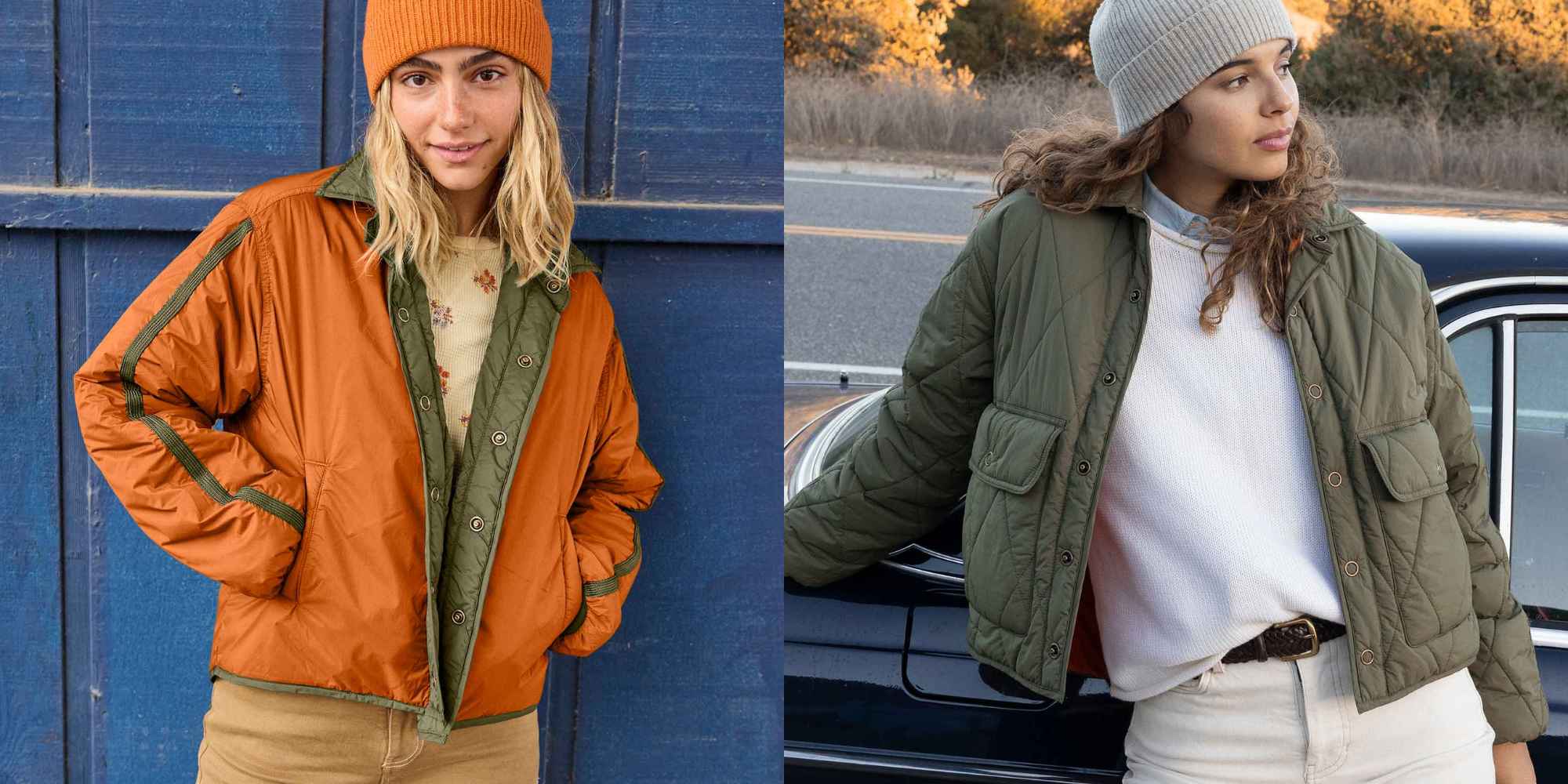
This Nomader jacket is reversible, packable, and water-resistant. In other words, it’s the ideal item to take with you for outdoor adventures. It’s made from recycled nylon and lightly quilted for warmth.
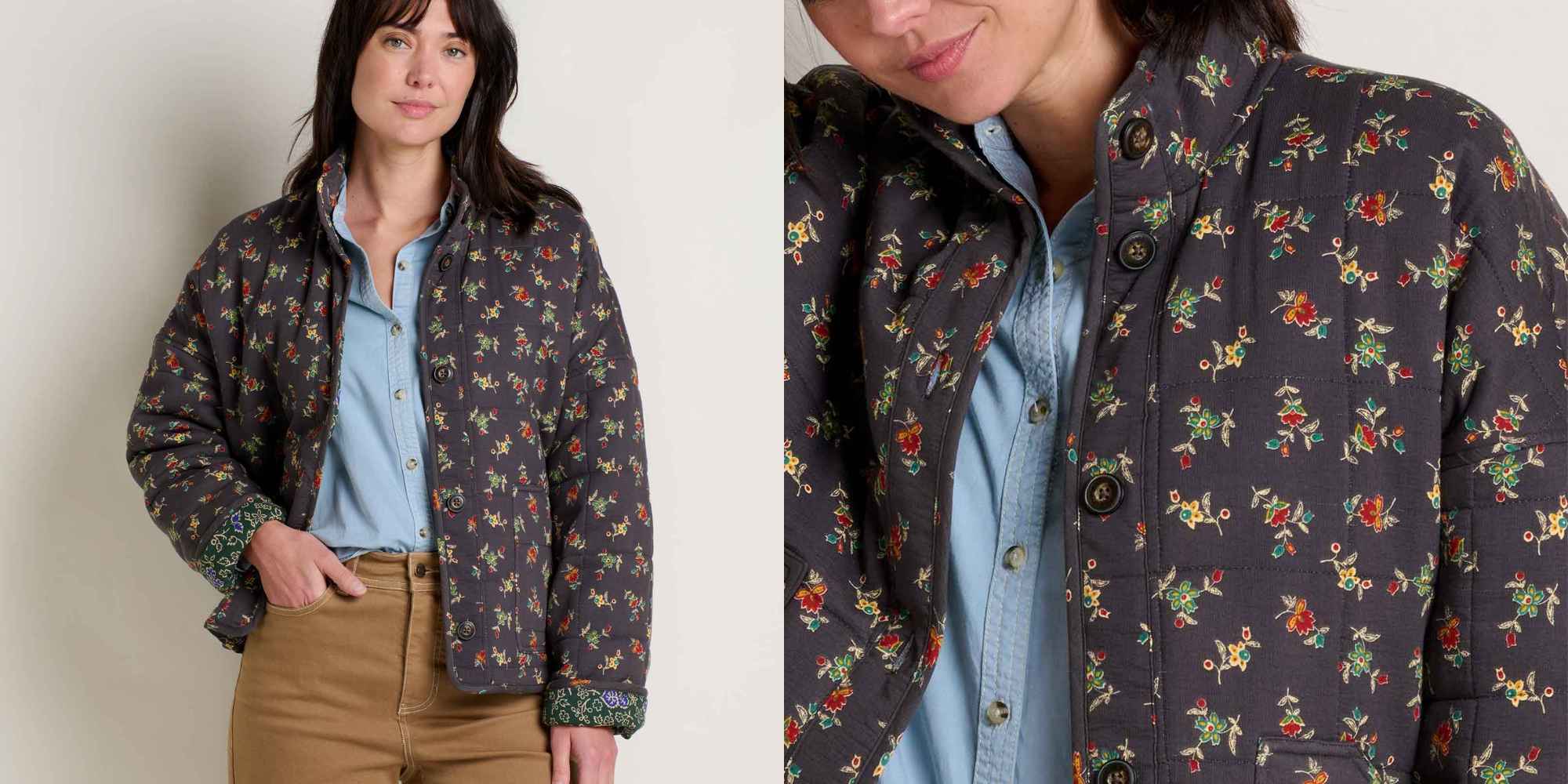
Toad&Co picked the crepe-like organic cotton for this jacket so that you could fold it away in a bag and have it still look presentable when you pull it out. It’s also packed with recycled polyester padding for extra warmth.
 Balsam Cutoff TrousersThese Balsam Trousers are made with a tiny bit of stretch and a special waistband for comfort, so they’ll flex with you and feel good all the time. The neutral brown colour also goes with so many options.
Balsam Cutoff TrousersThese Balsam Trousers are made with a tiny bit of stretch and a special waistband for comfort, so they’ll flex with you and feel good all the time. The neutral brown colour also goes with so many options.These Balsam Trousers are made with a tiny bit of stretch and a special waistband for comfort, so they’ll flex with you and feel good all the time. The neutral brown colour also goes with so many options.
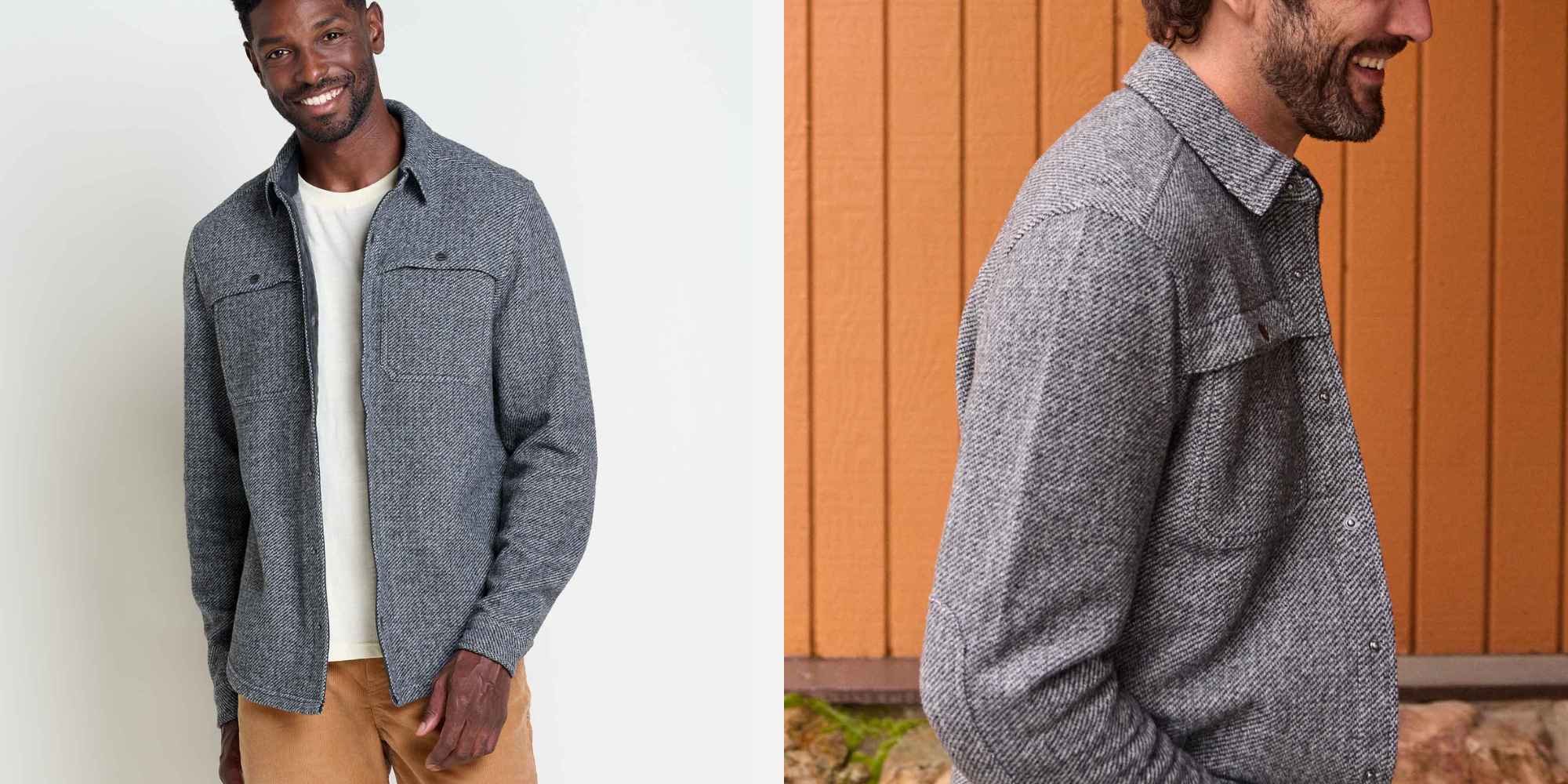
Going from a walk to dinner? From the office to drinks? This Kennicott shirt jacket fits the bill for all of the above. The smart twill fabric incorporates recycled Italian wool.

This is Toad&Co’s Re-Form Herringbone: a blend of recycled cotton and polyester that offers a soft drape and an attractive herringbone weave that looks smarter than the average checked shirt.
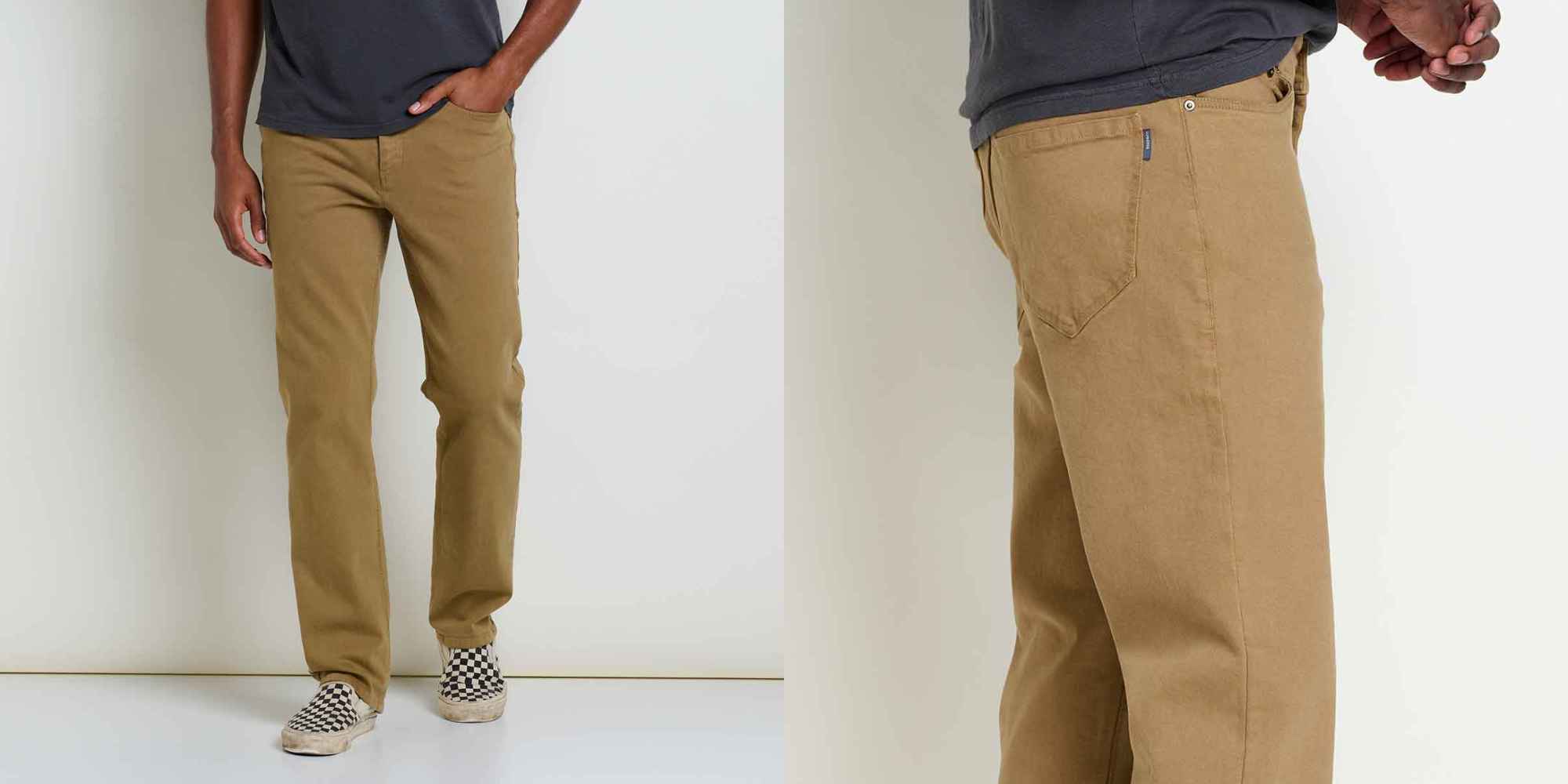
Like the women’s equivalent, these Balsam trousers have a touch of stretch and a comfortable ‘FlexForm’ waistband that mean they’re going to feel comfortable from the get-go—and you won’t need to worry about a belt, either.
Discover more of Toad&Co’s clothes.
The post How Toad&Co’s Clothes Help Everyone Enjoy the Outdoors appeared first on Good On You.
Green Living
50 DIY Christmas Presents Anyone Can Make
Last Updated on November 21, 2025
If you’re on the handmade Christmas kick this year, you’re not alone. So am I!
I’m choosing presence over presents this year and bringing back the 90s Christmas I loved as a kid – simple, crafty, low pressure, and full of small moments that feel meaningful.

If you want to gift thoughtfully, and without breaking the bank, these DIY Christmas presents are for you. There’s something for everyone on this list – whether you prefer easy or complex DIYs.
I’ve included all kinds of DIYs – beauty, cooking, fashion, and practical gifts alike. Best of all? Many of these tutorials are zero waste (or close to it).
what are good homemade Christmas gifts?
Good homemade Christmas gifts include consumable items, like homemade nut butters, vanilla extract, or jams. But not all homemade gifts are edible – you can also make items like bath bombs, candles, body scrubs, beeswax wraps, and so much more.
If you’re extra crafty, you could even make wooden gifts (like shelving or tablet holders), ceramic items (like mugs or jewelry), or knitted/crocheted pieces (like blankets, scarves or hats).
It all depends on your level of skill, time at your disposal, and ingredients/materials you have access to.

what are good inexpensive Christmas gifts?
Some good inexpensive Christmas gifts are DIY cornstarch ornaments, handmade body or lip scrub, seasoned salt blends, and homemade treats (like these chocolate chip cookies or vegan sugar cookies).
And never forget to hit up your local thrift store – you can find so many great items that would make affordable gift baskets!
Wrapping DIY Christmas gifts also doesn’t have to be expensive. Reusing gift bags and ribbons from last year, upcycling packaging paper, or even repurposing a scarf for furoshiki wrap are all low-waste and affordable!
RELATED: Gift Wrapping: How to Keep It Easy, Eco and Chic
how can I make a last minute gift?
You can make a last minute gift by getting crafty using the materials you have on hand!
For example, if you have a cardboard box, why not try making an upcycled cardboard dollhouse, vehicle, or pirate ship for a child? For adults, a DIY storage container or a shoe rack works.
One of my fav last minute gifts is scented bath salts in an upcycled glass jar – just a little Epsom salt and essential oil blends will do the trick!
Here’s my list of DIY Christmas gifts – something for everyone and every skill level.

- Bath salts
- DIY makeup like mascara/eyeliner, or lip to cheek
- Bath bombs
- Lip scrub
- Lip balm
- Face mask
- Body lotion
- Natural perfume
- Dry shampoo
- Shampoo bar
- Body soap
- Deodorant
- Rose water toner
- Hand-poured coconut/soy/beeswax candles
- Simmer pot in a jar
- Cookie, brownie, soup mix or hot cocoa mix in a jar
- Handmade seasoning blends
- Vanilla extract
- Vegan caramels or plant-based butter wrapped in compostable parchment paper
- Herb or citrus infused olive oil
- Peanut butter + jam
- Beeswax wraps
- Apple or pumpkin butter
- Sourdough or no-knead artisan bread
- Finished embroidery hoops
- Embroidered pillows, tote bags, clothes or cloth napkins
- Sewn cotton rounds
- Knitted scarf, hat, gloves, sweater, or blanket
- Hand warmers
- Quilt blanet, quilted coat or quilted wallet
- Tie dyed secondhand silk scarves, clothing or sheets
- Hand painted or drawn artwork
- Air dry clay paint palette
- DIY wooden frame for paintings or print photos
- Handmade ceramics (mugs, chawan, chasen holder, vase, spoon rest, etc.)
- Woodworked items (birdhouse, shelving, bookcase, wall guitar mount)
- Carving wooden bowls by hand
- Natural branch coasters
- Plant propagations in one of these DIY planters
- Seed balls using native seeds
- Handwoven baskets or bowls
- Macrame produce bag
- Macrame plant hanger
- Fabric paper mache bowls
- Upcycled paper earring jewelry
- Clay earrings
- Handmade plush toys
- Felt ‘food’ toys
- Wooden toys (like vehicles, blocks, or dollhouses)
- Knit or crocheted baby clothes
What do you think of these DIY Christmas presents? Let me know in the comments!
The post 50 DIY Christmas Presents Anyone Can Make appeared first on Going Zero Waste.
Green Living
8 Best Non Toxic Rugs For a Sustainable Home
Last Updated on November 6, 2025
Did you know most rugs are made from polyester, aka plastic? Arguably, a good chunk of our furniture and home decor is nowadays.
And lets not forget – rugs can get a lot of foot traffic. If it’s made from polyester, chances are those plastic fibers are going to shed and get onto us. Or worse, in us.

Some of the links in this post are affiliate links; for more information please see my disclosure policy.
Microplastics have been found in human feces, blood, and even placentas. And according to a study from Stanford University, those who had microplastics in their plaque had a higher risk of heart attack, stroke and death than those who didn’t.
On top of this, 5 billion pounds of rugs go to waste each year – that’s 2% of total US landfill. And if they’re made from plastic? They won’t biodegrade.
It’s more important than ever to reduce our exposure to microfibers where we can. Which is why I’ve rounded up the best non toxic rugs on the market.
what is the least toxic rug?
The least toxic rug will have sustainable materials and use no harsh chemicals (like PFAs) in their production.
Here’s what to look for when purchasing a non-toxic rug:
- Sustainable materials, such as organic cotton, jute, sisal or wool
- Low-waste packaging + delivery
- Natural, non-synthetic dyes
- Third-party certifications like OEKO-TEK, Fair Trade, GOTs
- Easy to spot-clean or machine wash
- Available in various styles, patterns + colors to suit your needs
do all rugs have PFAS?
According to Department of Toxic Substances Control (DTSC), only four samples of 201 carpets and rugs were found to contain more than 100 parts per million in their fibers, indicating PFAS were intentionally added to the products.
However, while PFAs may not be a huge concern for rugs, microplastic pollution is, specifically if your carpet is synthetic. Your best bet is to check the material your rug is made from and choose natural fibers whenever possible.
what is the best non-toxic rug for nursery?
The best non-toxic rug for a nursery would be made from natural materials like wool and organic cotton (which are soft on baby’s skin).
I recommend also checking for natural latex for the rug backing and underlay pads. Brands on this list that offer kid-friendly sizes and patterns include Lorena Canals, Nestig, Quince, and Loomy (more on each below).
what brand of rugs are non-toxic?
The brands of rugs that are non-toxic are listed below. I’ve gone ahead and highlighted some of my favorite features of each brand, but it isn’t an exhaustive list. Be sure to check out their websites for more information.

1. hook and loom
- Various rug sizes, shapes + patterns
- Made from GOTs certified organic cotton, recycled cotton + wool
- No dyes or harmful chemicals
- No latex
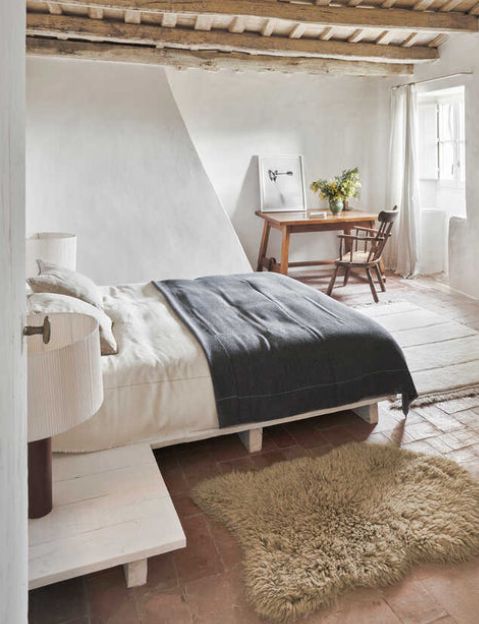
2. lorena canals
- Various rug sizes, shapes + patterns
- Handmade by artisans using recycled materials like organic cotton + wool
- Nontoxic dyes
- Make your own option
- Machine washable
- Rugcycled line made from recycled materials in their own factory

3. sabai
- Field rug
- Woven using wool + jute
- Available in 3 varying sizes
- Rug pad add-on available for reduced movement
- Certified B Corporation

4. quince
- Various sizes + patterns, best known for vintage-inspired looks
- Made from natural materials like wool, jute, + cotton
- Handcrafted by artisans in India
- Transparent pricing practices
- Compostable poly bags + recycled plastic mailers

5. west elm
- Rugs for every area of the home, in varying sizes
- Made from wool, jute, hemp, cotton, TENCEL + recycled materials
- Handspun by skilled artisans in India
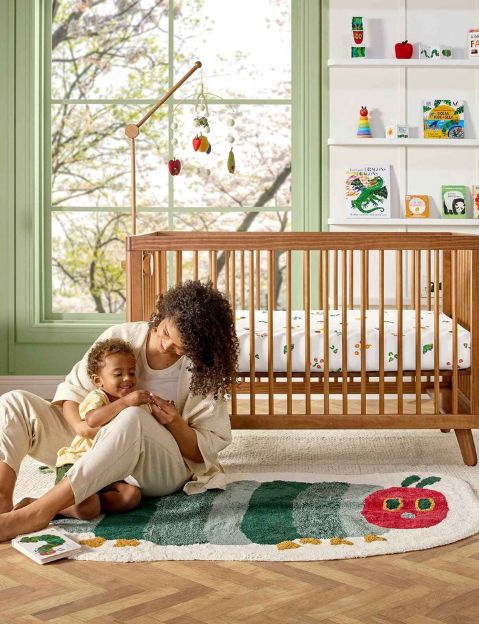
6. nestig
- Area + washable rugs made with fun shapes/designs for babies + kids
- Washable rugs made with organic cotton + nontoxic dyes
- Area rugs made with cotton + each colored element crafted from recycled cotton
- Handmade in Brazil

7. cold picnic
- Various rug shapes + sizes, abstract patterns + bold colors
- Made with wool, bamboo silk, cotton, hemp, + deadstock materials
- Designed in a Brooklyn studio, handmade by artisans in India
- Committed to reducing packaging waste where possible
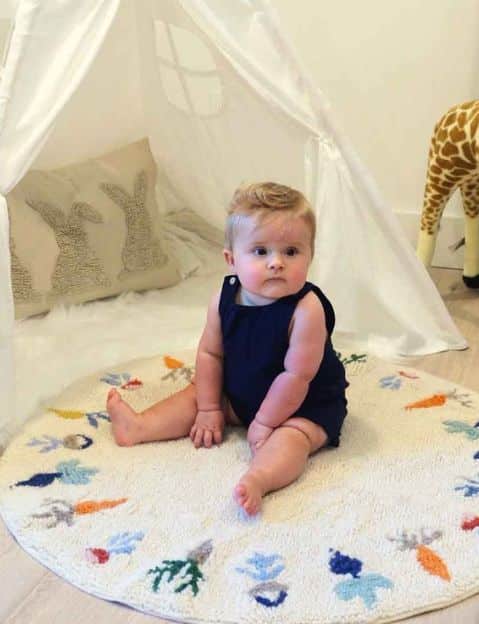
8. loomy
- Various rug sizes, shapes + patterns
- Made from banana silk, hemp, jute, recycled fiber, viscose, or wool
- Any colored yarn dyed using low-impact techniques
- Handcrafted by indigenous artisans
So what do you think of these non toxic, sustainable rugs? Let me know in the comments!
The post 8 Best Non Toxic Rugs For a Sustainable Home appeared first on Going Zero Waste.
-
Climate Change4 months ago
Guest post: Why China is still building new coal – and when it might stop
-
Greenhouse Gases4 months ago
Guest post: Why China is still building new coal – and when it might stop
-
Climate Change2 years ago
Spanish-language misinformation on renewable energy spreads online, report shows
-

 Greenhouse Gases2 years ago
Greenhouse Gases2 years ago嘉宾来稿:满足中国增长的用电需求 光伏加储能“比新建煤电更实惠”
-
Climate Change Videos2 years ago
The toxic gas flares fuelling Nigeria’s climate change – BBC News
-

 Climate Change2 years ago
Climate Change2 years ago嘉宾来稿:满足中国增长的用电需求 光伏加储能“比新建煤电更实惠”
-

 Carbon Footprint2 years ago
Carbon Footprint2 years agoUS SEC’s Climate Disclosure Rules Spur Renewed Interest in Carbon Credits
-
Climate Change2 years ago
Why airlines are perfect targets for anti-greenwashing legal action



